The New York Times (NYT), in a July 30th story titled “How Did the Park Fire Get So Big, So Fast?” claims that “[h]eat has been breaking records all summer, and Dr. Williams said records will probably continue to fall over the next several years as the burning of fossil fuels continues to add greenhouse gases to the atmosphere.”
This is false. The article itself provides no data or citations to support this claim but rather relies on opinions from so-called climate experts who have no hands-on connection to the fire whatsoever.
Having spent 35 years in Chico, CA, the Park fire is one of three recent wildfires with which I have personal hands-on and boots on the ground experience. The other two were the Camp Fire in 2018, and the Dixie fire in 2021. All these fires affected me personally and the people around me.
Yet somehow NYT and their bevy of so-called experts think they can divine the cause and conditions that drove these fires from their offices from afar. In each case, NYT has blamed climate change as either a driver or contributor to these three fires without so much as a shred of proof. In fact, NYT contradicts their own claims in their article in the table of the top ten fires in California by acreage burned:
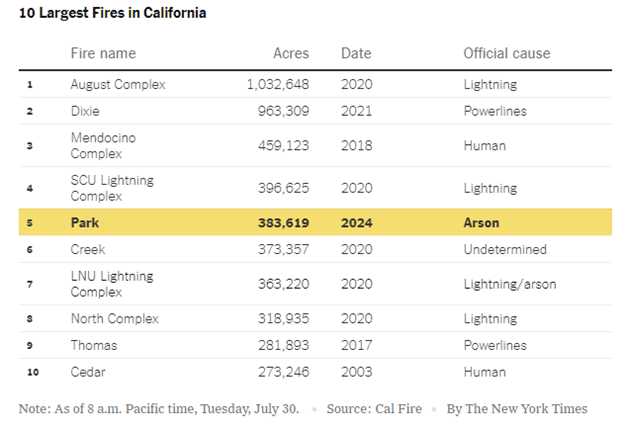
Climate change isn’t listed as a cause in any of them. However, that doesn’t stop the “experts” they interviewed for the story to try making a climate connection where none exists:
July 22, two days before the fire began, was Earth’s hottest day on record. June was the 13th consecutive month to break a global heat record. Some areas burned by the Park fire saw their single-hottest 30-day periods on record just before the blaze broke out.
Dr. Williams compared the dry conditions to those preceding California’s second-largest wildfire, the 2021 Dixie fire, which began during a drought and burned almost one million acres. The state has since emerged from drought, which makes the heat’s effect on fuels even more notable, he said.
“It was an exceptional heat wave, and an exceptional drying of the vegetation,” said Daniel Swain, a climate scientist at U.C.L.A. and the National Center for Atmospheric Research. Wetter winters led to less-severe fire seasons in 2022 and 2023. But extreme heat this summer, with more hot weather in the forecast, means “we’ve kiln-dried all that extra fuel,” Dr. Swain said.
The Park fire was started by arson, according to Cal Fire. The dry vegetation that allowed it to burn so quickly had a very clear fingerprint of climate change, Dr. Swain said.
By my observations, this sort of causality shoehorning (to coin a phrase) is becoming increasingly common among journalists and climate advocates as they strain to fit any weather event or catastrophe into the climate change narrative.
Swain’s claim of “a very clear fingerprint of climate change” on dry vegetation that fueled the Park fire is little more than his personal opinion. He offers no scientific citation or basis for his claim.
While there was indeed a heat wave prior to the Park fire, that had no bearing on the fire at all. The area where the fire ignited, Butte County California and the most-burned area in Tehama County are not in drought conditions according to the U.S. Drought Monitor for July 23rd – the day before the Park fire was ignited by a criminal arsonist.

So “climate change caused drought” and resultant abnormally dry conditions didn’t figure into the Park fire at all. The fire wouldn’t exist without the criminal act of arson. I would not be surprised at if the next episode of causality shoehorning is a story claiming “Climate Change Causes More Arsonists.”
The arson ignition point, in Chico’s Bidwell Park, is in the foothills of the Sierra Nevada. Just to the north of that point huge acreages of grassland and scrub brush exist. Combine that ignition with the sustained southerly winds that day of 20-25 mph, and it is no surprise that the fire rapidly spread north. Rick Carhart, the Public Information Officer for CalFire in Butte County and a Chico resident for decades, confirmed in a telephone interview that the area “had not naturally burned in several decades, and had no control burns to reduce fuel loads.” He added that these “high fuel loads, combined with the wind that day made a very aggressive fire.”
Climate change contributed nothing to the actual circumstances or rapid spread of the fire – local weather and a criminal act are at fault. The drying of grasses (which happens every spring) and the heat wave (which happens every summer) are both weather patterns which operate on short-term time scales as opposed to long-term climate change.
My colleague, Heartland Institute research fellow Linnea Lueken, published a scathing factual rebuttal last year of a case with The Sacramento Bee making similar but baseless claims like the NYT when they attempted to connect climate change to wildfires and their natural drivers, such as lightning. She writes:
The Intergovernmental Panel on Climate Change finds no climate signal, nor increasing trend, behind thunderstorms, or lightning occurrences. Also, NASA satellites have documented a global long-term decline in wildfires. NASA reports satellites have measured a 25-percent decrease in global lands burned since 2003.
Examining wildfires in California in particular, research shows massive wildfires have regularly swept through the state. Indeed, a 2007 paper in the journal Forest Ecology and Management reported that prior to European colonization in the 1800s, more than 4.4 million acres of California forest and shrub-land burned annually. As compared to the 4.4 million California acres that burned each year prior to European colonization, only 90,000 acres to 1.6 million California acres burn in a typical year now.
Clearly, there is no climate change driving component to California wildfires at all. If there were, fires in the present would be consuming much more than 4.4 million acres annually – but this isn’t happening. The simple fact is, Arsonists Are Responsible for More Wildfires than Climate Change. The intensity and coverage of wildfire varies greatly from year to year, as evidenced by the 2022 NYT story, Why California’s 2022 Wildfire Season Was Unexpectedly Quiet. A map of fires from year to year in the article demonstrates this well:

Of course, in that article they can’t resist blaming climate change, only providing cherry-picked data back to 1990 to bolster their claim, while completely ignoring the huge fires of the past.
The NYT believes, like some sort of diagnostic remote “telemedicine” call, that they and their experts can divine the climate connections to the fire from offices in New York and from so called “climate experts” sitting in their offices elsewhere who know better about what is going on than people with boots on the ground.
It is a shameful and obvious demonstration that the NYT cares more about furthering the climate agenda, than they do about reporting the facts.





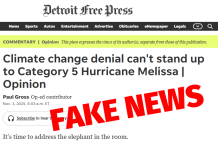
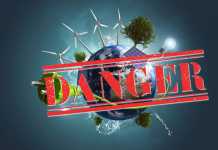






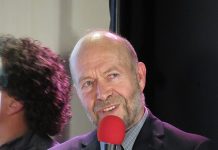
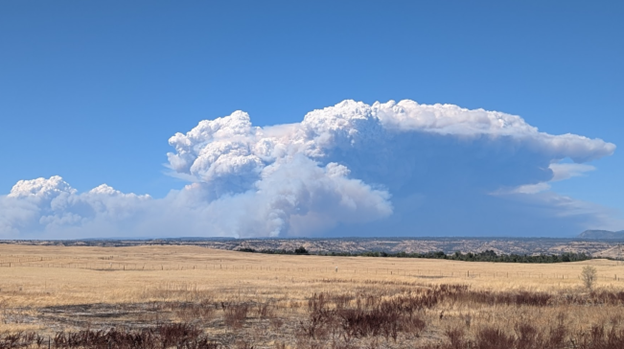









Sadly, the NYT has become a reliable purveyor of misinformation and upholder of the climate alarmist agenda. Such sources routinely use concocted terms like “climate denier” that are objectively nonsensical but so common now that we hardly notice. But I was surprised to see the equally nonsensical term “climate advocates” in the article. I must be a “sun, rain, and snow advocate”. Or was term meant to be “climate alarm advocates”?
This wildfire is another example of lack of having firebreaks for grasslands and forests! Forest management has been sorely lacking in these areas to prevent rapid fire damage and destruction of structures! Quit blaming the climate and start concentrating on ways to mitigate these disasters! Easy to blame the climate when fire was actually human caused which was accelerated by high winds and low humidity which are common every fire season! What can they do about the climate anyway to prevent this, absolutely nothing which is what they never explain but just blame fossil fuels! Fires are inevitable but the fuel source can be reduced through proper fire control measures!